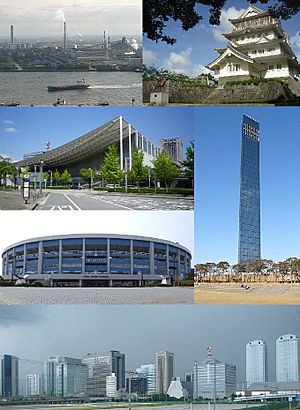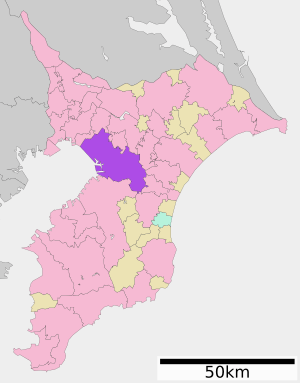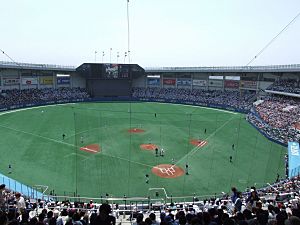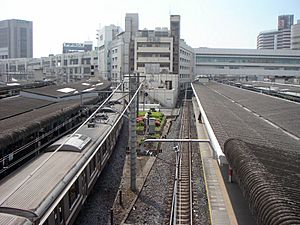Chiba (city) facts for kids
Quick facts for kids
Chiba
千葉市
|
|||
|---|---|---|---|
| Chiba City | |||

Top: Coastal industrial area, Chiba City Folk Museum
Middle: Makuhari Messe, Chiba Port Tower, Chiba Marine Stadium Bottom: Skyscrapers of Makuhari on the coast |
|||
|
|||

Location of Chiba in Chiba Prefecture
|
|||
| Country | |||
| Region | Kantō | ||
| Prefecture | Chiba Prefecture | ||
| Area | |||
| • Total | 271.77 km2 (104.93 sq mi) | ||
| Population
(June 1, 2019)
|
|||
| • Total | 979,768 | ||
| • Density | 3,605.14/km2 (9,337.26/sq mi) | ||
| Time zone | UTC+9 (Japan Standard Time) | ||
| - Tree | Zelkova serrata | ||
| – Flower | Nelumbo nucifera | ||
| – Bird | Little tern | ||
| Phone number | 043-245-5111 | ||
| Address | 1-1 Chiba-minato, Chūō-ku, Chiba-shi 260-8722 | ||
| Website | https://www.city.chiba.jp/ | ||
| Chiba | |||||
|---|---|---|---|---|---|

"Chiba" in kanji
|
|||||
| Japanese name | |||||
| Kanji | 千葉 | ||||
| Hiragana | ちば | ||||
| Katakana | チバ | ||||
|
|||||
Chiba (千葉市, Chiba-shi, pronounced [tɕiꜜba]) is a major city in Japan. It is the capital of Chiba Prefecture. The city is located about 40 kilometers (25 miles) east of Tokyo, right on Tokyo Bay.
Chiba became a special "government-designated city" in 1992. This means it has more power to manage its own affairs. As of June 2019, nearly 980,000 people lived there.
Chiba City is a very important seaport in the Kantō region. Its port, Chiba Port, handles a huge amount of cargo. While many people live in Chiba, there are also many factories and warehouses along the coast.
The city has several important areas. Makuhari is a modern business district by the water. It is home to Makuhari Messe, a large convention center. Central Chiba is where the main government offices are located.
Chiba is famous for its Chiba Urban Monorail. This is the longest suspended monorail in the world! You can also visit the Kasori Shell Midden, which is the world's largest shell mound. Inage Beach is Japan's first artificial beach. The Chiba Zoological Park is also popular, especially because of Futa, a famous standing red panda.
Contents
What Does "Chiba" Mean?
The name "Chiba" comes from two Japanese kanji characters.
So, Chiba means "thousand leaves"! This name first appeared a long time ago for a regional office. Later, a powerful family called the Chiba clan adopted this name. They lived in the area during the Heian period and were very influential. The name "Chiba" was chosen for the whole Chiba Prefecture when it was created in 1873.
A Look at Chiba's Past
Early Days of Chiba
The first records of Chiba city go back to the late Heian period. A strong warrior named Taira Tsuneshige moved to the area. He became the administrator of Chiba District. He then called himself Chiba Tsuneshige (千葉常重). He used this area to become a powerful leader in the Kantō region.
His son, Chiba Tsunetane (千葉常胤), helped Minamoto no Yoritomo create the Kamakura shogunate. Tsuneshige built a large home and many temples in what is now Chiba City. The area grew into a jōkamachi (castle town) and did very well under the Chiba clan.
Medieval Times
The Chiba clan's power started to fade during the Nanboku-chō period and Muromachi period. Other clans, like the Hara clan, took control. The Hara clan built Inohana Castle. Later, other clans fought for control, and eventually, the Chiba clan lost its power completely.
Later History of the City
During the Edo period, different clans governed parts of the area. Chiba became a busy shukuba (post-town) for travelers. This meant it was an important stop along major roads.
Modern Chiba
After the Meiji Restoration in 1868, Chiba Prefecture was formed in 1873. Chiba Town was chosen as the capital because of its central location. The city grew quickly after the Sobu Main Line railway opened. It became the main center for politics, business, and culture in Chiba Prefecture.
Chiba City was officially created on January 1, 1921. Over the years, many smaller villages and towns joined Chiba. The city's land area also grew a lot thanks to land reclamation (creating new land from the sea).
During World War II, Chiba was a major center for making military goods. Because of this, it was heavily bombed in 1945 and almost completely destroyed. After the war, Chiba rebuilt and became a key part of the Keiyō Industrial Zone. Finally, on April 1, 1992, Chiba became a special "Designated City of Japan."
How Many People Live in Chiba?
Chiba's population has grown a lot over the last 70 years.
As of February 2016, about 972,861 people lived in Chiba. This means there were about 3,580 people per square kilometer. The city covers an area of 271.76 square kilometers. About 2% of the people living in Chiba are foreign residents. As of 2022, Chiba is the 13th most populated city in Japan.
| Historical population | ||
|---|---|---|
| Year | Pop. | ±% |
| 1921 (founding) | 33,887 | — |
| 1930 | 49,088 | +44.9% |
| 1940 | 92,061 | +87.5% |
| 1950 | 133,944 | +45.5% |
| 1960 | 241,615 | +80.4% |
| 1970 | 482,133 | +99.5% |
| 1980 | 746,430 | +54.8% |
| 1990 | 829,455 | +11.1% |
| 2000 | 887,164 | +7.0% |
| 2010 | 961,749 | +8.4% |
| 2020 | 974,951 | +1.4% |
Chiba's Weather
Chiba has a humid subtropical climate. This means it has hot summers and cool to mild winters. It rains a good amount throughout the year, but less in winter.
| Climate data for Chiba (1991−2020 normals, extremes 1966−present) | |||||||||||||
|---|---|---|---|---|---|---|---|---|---|---|---|---|---|
| Month | Jan | Feb | Mar | Apr | May | Jun | Jul | Aug | Sep | Oct | Nov | Dec | Year |
| Record high °C (°F) | 20.7 (69.3) |
24.7 (76.5) |
25.3 (77.5) |
28.7 (83.7) |
31.7 (89.1) |
35.0 (95.0) |
37.8 (100.0) |
38.5 (101.3) |
36.2 (97.2) |
32.8 (91.0) |
26.0 (78.8) |
24.3 (75.7) |
38.5 (101.3) |
| Mean daily maximum °C (°F) | 10.1 (50.2) |
10.7 (51.3) |
13.8 (56.8) |
18.7 (65.7) |
23.0 (73.4) |
25.6 (78.1) |
29.4 (84.9) |
31.0 (87.8) |
27.5 (81.5) |
22.3 (72.1) |
17.3 (63.1) |
12.5 (54.5) |
20.2 (68.4) |
| Daily mean °C (°F) | 6.1 (43.0) |
6.6 (43.9) |
9.6 (49.3) |
14.5 (58.1) |
18.9 (66.0) |
21.9 (71.4) |
25.7 (78.3) |
27.1 (80.8) |
23.8 (74.8) |
18.6 (65.5) |
13.4 (56.1) |
8.6 (47.5) |
16.2 (61.2) |
| Mean daily minimum °C (°F) | 2.4 (36.3) |
2.8 (37.0) |
5.7 (42.3) |
10.6 (51.1) |
15.4 (59.7) |
19.0 (66.2) |
23.0 (73.4) |
24.3 (75.7) |
21.0 (69.8) |
15.6 (60.1) |
9.9 (49.8) |
4.9 (40.8) |
12.9 (55.2) |
| Record low °C (°F) | −5.1 (22.8) |
−5.2 (22.6) |
−4.4 (24.1) |
0.4 (32.7) |
6.8 (44.2) |
9.1 (48.4) |
12.5 (54.5) |
16.5 (61.7) |
10.7 (51.3) |
5.8 (42.4) |
−0.9 (30.4) |
−3.7 (25.3) |
−5.2 (22.6) |
| Average precipitation mm (inches) | 67.5 (2.66) |
59.1 (2.33) |
111.3 (4.38) |
110.4 (4.35) |
122.3 (4.81) |
150.9 (5.94) |
136.5 (5.37) |
115.7 (4.56) |
204.7 (8.06) |
225.7 (8.89) |
94.1 (3.70) |
56.8 (2.24) |
1,454.7 (57.27) |
| Average snowfall cm (inches) | 2 (0.8) |
4 (1.6) |
0 (0) |
0 (0) |
0 (0) |
0 (0) |
0 (0) |
0 (0) |
0 (0) |
0 (0) |
0 (0) |
0 (0) |
7 (2.8) |
| Average precipitation days (≥ 0.5 mm) | 6.2 | 6.8 | 11.2 | 10.7 | 11.2 | 12.4 | 10.7 | 8.5 | 12.0 | 11.5 | 8.8 | 6.5 | 116.6 |
| Average relative humidity (%) | 53 | 55 | 61 | 66 | 71 | 77 | 78 | 77 | 77 | 73 | 66 | 57 | 68 |
| Mean monthly sunshine hours | 191.6 | 165.3 | 167.5 | 177.0 | 180.5 | 126.9 | 162.7 | 189.4 | 134.6 | 131.6 | 143.6 | 174.8 | 1,945.5 |
| Source: Japan Meteorological Agency | |||||||||||||
Fun Things to See and Do in Chiba
Chiba has many interesting places to visit!
Cool Places to Explore
- Chiba Zoo
- Makuhari Messe (a huge convention center)
Parks and Green Spaces
- Chiba Park
Sports in Chiba

Chiba is a great place for sports fans. It hosts annual running races like the International Chiba Ekiden and the Chiba International Cross Country. You can also find the Chiba Velodrome here, which is a track for bicycle racing. The city also hosts the Bridgestone Open golf tournament.
Chiba is home to several professional sports teams:
| Club | Sport | League | Home Venue | Started |
|---|---|---|---|---|
| Chiba Lotte Marines | Baseball | Pacific League | Chiba Marine Stadium | 1950 |
| JEF United Ichihara Chiba | Football | J. League Division 2 | Fukuda Denshi Arena | 1946 |
Getting Around Chiba
Airports Near Chiba
Chiba City does not have its own commercial airport. The closest major airports are Narita International Airport and Tokyo International Airport (Haneda).
Trains and Monorails
The unique Chiba Urban Monorail runs through the city. Major train stations include:
- Chiba Station (for Sobu Line, Sotobō Line, Uchibo Line, Sōbu Main Line, Narita Line, and transfers to the Chiba Urban Monorail)
- Keisei Chiba Station (for Keisei Chiba Line)
- Soga Station (for Keiyō Line, Sotobō Line, Uchibo Line)
Major Roads
Several important highways and national routes pass through Chiba:
- Higashi-Kantō Expressway (connects to Tokyo, Narita, and Kashima)
- Tateyama Expressway (connects to Kisarazu)
- Keiyō Road
- Chiba-Tōgane Road (Japan National Route 126)
- Japan National Route 14
- Japan National Route 16
- Japan National Route 51
- Japan National Route 128
- Japan National Route 357
Learning in Chiba
Colleges and Universities
Chiba is home to many higher education institutions:
- Chiba University
- Chiba Prefectural University of Health Sciences
- Kanda University of International Studies
- Tokyo Dental College
- Shukutoku University
- Keiai University
- Chiba Keizai University
- Tokyo University of Information Sciences
- The Open University of Japan
- Uekusa University
- Teikyo Heisei University (Chiba campus)
- Chiba Meitoku College
- Japan Christian Junior College
High Schools
There are 20 public high schools run by the Chiba Prefectural Board of Education. Two public high schools, including Inage Senior High School, are run by the Chiba City Board of Education. Chiba also has nine private high schools, such as Makuhari Junior and Senior High School.
Elementary and Middle Schools
Chiba has 114 public and one private elementary school. It also has 59 public and one private middle school.
International Schools
- Chiba Korean Primary and Junior High School
Hospitals and Clinics
Chiba has several hospitals and clinics, including:
- Chiba Kaihin Hospital (Mihama-ku)
- Chiba University Hospital (Chuo-ku)
- Kashiwado Hospital (Chuo-ku)
- Tokyo Dental College Chiba Hospital (Mihama-ku)
- Koizumi Clinic (Hanamigawa-ku)
- Mizuno Clinic (Hanamigawa-ku)
- Hirayama Hospital (Hanamigawa-ku)
Chiba's Global Connections
Sister Cities
Chiba has special "sister city" relationships with cities around the world. These partnerships help promote cultural exchange and understanding:
 North Vancouver, Canada (since 1970)
North Vancouver, Canada (since 1970) Asunción, Paraguay (since 1970)
Asunción, Paraguay (since 1970) Houston, United States (since 1972)
Houston, United States (since 1972) Quezon City, Philippines (since 1972)
Quezon City, Philippines (since 1972) Minneapolis, United States (since 1986)
Minneapolis, United States (since 1986) Düsseldorf, Germany (since 2019)
Düsseldorf, Germany (since 2019)
Friendship Cities
Chiba also has "friendship city" agreements:
Famous People from Chiba
Many well-known individuals have connections to Chiba:
- Masaki Aiba, a member of the music group Arashi (born in Chiba)
- Pata, guitarist for X Japan and Ra:IN
- Yukihiro, drummer for L'Arc-en-Ciel
- Daiki Arioka, a member of the group Hey! Say! JUMP
- Mirei Kiritani, actress, model, and news anchor
- Kentaro Miura, creator of the Berserk manga
- Tsukasa Fushimi, creator of the Oreimo series
- Tao Okamoto, a model
- Rena Kato, formerly of AKB48
- Reina Fujie, formerly of NMB48
- Rina Hidaka, a voice actress
- Cho Chikun, a famous Go-player
- Shiina Natsukawa, pop idol and member of TrySail
- Mitsuhiro Hidaka, rapper and member of AAA
- Kenta Yamashita, racing driver
- Seiji Ara, racing driver
- Daiki Hashimoto, Olympic gold medalist in gymnastics
- Wataru Watari, creator of My Youth Romantic Comedy Is Wrong, As I Expected
- Shinichi Yamaji, racing driver
- Hideki Konno, a video game director and producer
- Kaho Minagawa, rhythmic gymnast
- Kabosu, the Shiba Inu dog famous from the Doge meme
Images for kids
See also
 In Spanish: Chiba (Chiba) para niños
In Spanish: Chiba (Chiba) para niños





